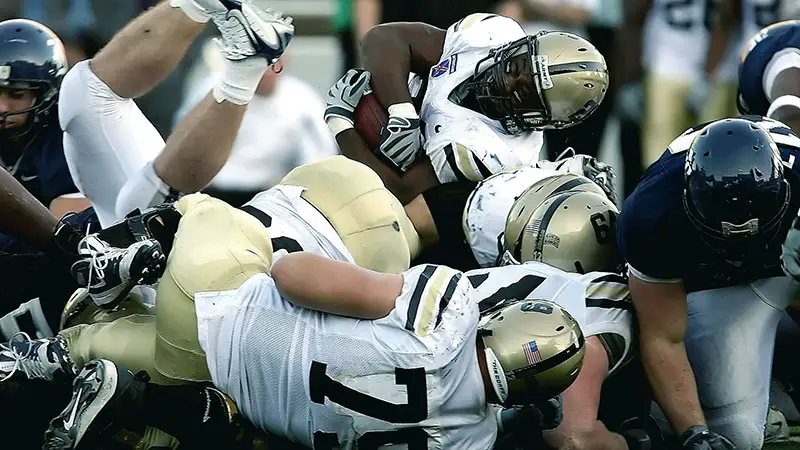When it comes to the fast-paced game of football, understanding the rules surrounding fumbles is crucial for players, coaches, and fans alike. Fumbles can quickly change the course of a game, turning the tide of momentum in an instant.
Knowing how these plays are governed by the rules can make the difference between a turnover and a game-changing recovery.
In football, a fumble occurs when a player loses possession of the ball during a play. This can happen due to a variety of factors, from a hard hit by an opponent to a simple mishandle.
Understanding the intricacies of fumble rules, such as how they impact possession and potential turnovers, is essential for anyone looking to grasp the nuances of the game.
Whether you’re a seasoned football enthusiast or just starting to delve into the sport, having a solid understanding of football fumble rules can enhance your appreciation for the game’s complexity and excitement.
Overview of Football Fumble Rules
In football, fumbles play a significant role in determining possession and can sway the momentum of a game in an instant. Understanding the rules governing fumbles is crucial for players, coaches, and fans to grasp the dynamics of turnovers and possession changes.
Here’s a breakdown of the key aspects of football fumble rules:
Definition of a Fumble
A fumble occurs when a player loses possession of the ball during a play. This can happen due to various factors such as a tackle, mishandling the ball, or being stripped by an opponent.
Impact on Possession
When a fumble occurs, the ball becomes live, meaning it is up for grabs by both teams. The team that recovers the fumble gains possession and the opportunity to advance the ball.
Turnovers and Scoring
Fumbles can lead to turnovers if the opposing team gains possession. This turnover can affect the outcome of the game by potentially setting up scoring opportunities or denying the offense a chance to score.
Challenges and Reviews
Coaches have the option to challenge fumble calls made by officials on the field. Replay reviews can help determine if a fumble did occur and which team rightfully gains possession.
Preventing Fumbles
Players are trained to secure the ball properly to minimize the risk of fumbles. Techniques such as high and tight ball carrying and ball protection drills are essential in avoiding turnovers.
Impact on Strategy
Coaches often factor in fumble risks when devising game plans. Understanding the likelihood of fumbles and their potential consequences can influence playcalling and team strategies.
Game-Changing Moments
Fumbles have the power to shift the momentum of a game dramatically. A timely fumble recovery or a costly turnover can alter the course of a match and impact the final outcome.
Fan Engagement
Knowing the rules of fumbles adds depth to a fan’s understanding of the game. Recognizing pivotal fumble moments enhances the excitement and anticipation during football games.
Proper Fumble Recovery
To properly recover a fumble, players need to follow specific steps to ensure possession retention.
- Locate the Ball: The first crucial step is for the player to quickly locate the fumbled ball on the field.
- Get Low and Secure: After spotting the ball, the player must get low to the ground, maintaining a strong and secure grip on the ball to prevent opponents from snatching it.
- Possession Control: Once the player has secured the ball, they need to tightly control it against their body to avoid losing possession during a recovery attempt.
- Protect the Ball: It’s essential to protect the ball by covering it with both arms and using the body as a shield against opponents trying to strip it away.
- Maintain Possession: Throughout the recovery process, the player must ensure continuous possession until the play is deemed complete to avoid turnovers.
Intentional Fumbling
It’s crucial to note that intentional fumbling is a strategic move used by players to advance their team’s position or gain an advantage during a football game.
Here are the steps involved in intentional fumbling:
- Initiating the Fumble: Players might opt to intentionally release the ball by loosening their grip or using their non-dominant hand to create an opportunity for their team.
- Timing is Key: Executing intentional fumbling at the right moment is vital. Players need to consider the field position, game clock, and the defensive situation to maximize the impact.
- Choosing the Right Moment: Players should assess the game scenario and the positioning of their teammates to ensure that intentional fumbling can lead to a beneficial outcome for their team.
- Risk Assessment: Before attempting intentional fumbling, players must weigh the potential risks against the potential rewards to make an informed decision.
- Team Communication: Coordination with teammates is essential when planning intentional fumbling to ensure everyone is on the same page and ready to capitalize on the strategic move.
Implementing intentional fumbling requires skill, awareness, and strategic thinking to turn what might seem like a mistake into a calculated play that can shift the momentum of the game in favor of the executing team.
Use of Fumbles in Games
In football games, teams may opt for alternatives to the traditional coin toss for determining initial possession. One such alternative involves the use of fumbles, where players compete in a controlled fumble recovery situation to determine possession.
Different Types of Fumbles
When it comes to football fumbles, understanding the various types is crucial for players, coaches, and fans. Here are some different types of fumbles explained:
The Backward Pass
In football, a fumble can also occur during a backward pass. This type of fumble happens when a player attempts to throw the ball behind the line of scrimmage to another player but loses control of the ball in the process.
It’s essential for players to maintain a secure grip on the ball during these plays to avoid turnovers.
Kicks From Scrimmage
Another type of fumble in football can occur during kicks from scrimmage. This type of fumble happens when a player mishandles the ball during a punt or a field goal attempt.
It is crucial for kickers and holders to have a strong connection and precise execution to prevent fumbles during these critical moments in the game.
Frequently Asked Questions
What is the definition of a football fumble?
A fumble in football happens when a player loses control of the ball while in possession of it, before the play is over.
Why is fumbling the ball intentionally considered a strategy?
Intentional fumbling can be a strategic move in football as it requires skill and strategic thinking to execute successfully, offering an element of surprise and game advantage.
How do fumbles impact possession changes in football?
Fumbles can lead to turnovers, causing possession changes from one team to the other, influencing the flow and outcome of the game.
What are the different types of fumbles in football?
Different types of fumbles can occur during backward passes and kicks from scrimmage, highlighting the importance of maintaining ball control in crucial game situations.
How can one prevent and recover from fumbling the ball in football?
Preventing and recovering from fumbles require solid techniques, focus, and concentration on ball security to minimize turnovers and retain possession effectively.
Conclusion
Understanding football fumble rules is essential for players, coaches, and fans to grasp possession dynamics and turnovers effectively, including intentional fumbling strategies.
Delving into intentional fumbling as a strategic move highlights the skill required for successful execution.
Exploring the use of fumbles in games to determine initial possession offers new insights into game dynamics, emphasizing the importance of ball control in different game situations.
Overall, comprehending these rules enhances individuals’ appreciation for the sport’s complexity and helps in preventing turnovers while maximizing strategic opportunities during gameplay.
This deeper understanding also sheds light on the significance of quick thinking and adaptability on the field, as well as the critical role that fumble recoveries can play in shifting the momentum of a game.
Mastering football fumble rules adds another layer of strategic thinking to both players’ and coaches’ gameplay approaches, ultimately leading to a more dynamic and engaging overall football experience.








Ashley Hopkinson